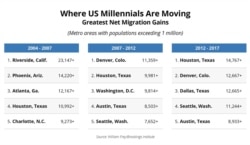Young American adults are staying put more since the Great Recession, but when they do move, they’re not going to the same places as they did before the economic downturn of 2007-2009.
In the three years leading up to the recession, more Americans in their 20s and 30s headed to Riverside (California), Phoenix, Atlanta, Houston and Charlotte (North Carolina), according to the U.S. Census Bureau’s American Community Survey.
“Those were more kind of ‘We’re coming there to buy a house and get a job and make things go,’” says demographer William Frey of the Brookings Institution.
Things changed during the recession and in the years that followed.
From 2007 to 2012, America's metro areas that gained the most millennials were Denver, Houston, Washington, D.C.; Austin (Texas) and Seattle. From 2012 to 2017, the metropolitan areas with the highest net millennial migration were Houston, Denver, Dallas, Seattle and Austin.
“Young people may not be finding the job that they want and they're not be able to buy a home that they'd like to buy,” Frey says. “At least they want to be in a place maybe where the action is for younger people, the kind with a young person's amenities, or what you might call places with a cool factor.”
Overall, U.S. millennials are moving at the lowest rate since at least 1996. In 2017, their migration rate was 17%, well below the pre-recession number of almost 23%.
Frey, who keeps expecting millennial migration rates to pick up, is disappointed with the numbers.
“Migration is good for the economy in the sense that people are more able to adapt to changing economic circumstances… if they move to places where jobs are being created,” Frey says.
“Especially if it's a movement to purchase a home and to start investing in their future in terms of wealth creation and so forth. I think that's important so that they're not stuck in a way that makes them feel like they're being left behind.”
Frey sees signs that millennials are starting to move to the suburbs and smaller metropolitan areas, as well as to cities located in the interior part of the United States rather than on either the East or West Coast.
“I'm suggesting that when we look at the next round of migration rates, when they come out, we're going to see a little bit more movement to those kind of more, you know, economically viable and prosperous areas rather than to the cooler areas,” he says.





